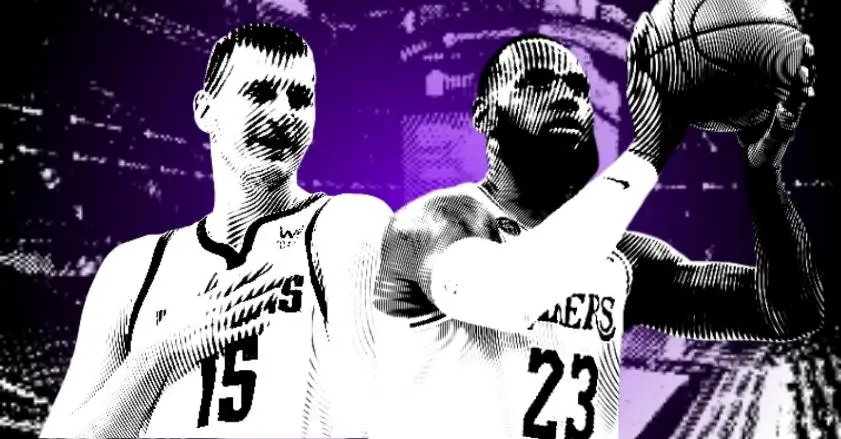Here’s a fun chart I made!
This is the % of total points scored in the NBA, split by position. For example, in 2021-2022, the last season on the chart, over 25% of all NBA points were scored by players labeled as shooting guards, and barely 15% of points were scored by small forwards. (Data is from Basketball Reference and subject to the position labels therein.)
Of course, total points scored is a tricky way to look at things. It turns out that players labeled as shooting guards played the most minutes in 2021-2022, which is why they scored more points.
So let’s look at it adjusted for minutes played:
Well, hello there, point guards! That tracks a little closer to what I expected. We can see the evolution of positional scoring-per-minute over time.
Lots of cool things pop out when looking at these two charts:
- The league, as a whole, became less efficient in the early 2000s (which absolutely checks out; those are the bad old days of NBA basketball). Interestingly, the center was considered dead during that time, but this data would suggest that, although they were indeed the worst at scoring, centers were only a bit less efficient and prolific than other positions in absolute terms.
- Centers are scoring more often now than they have at any point in this timeframe. Jokic and Embiid pace that list, of course, but don’t sleep on guys like Karl-Anthony Towns, Christian Wood, and Jonas Valanciunas scoring at a very efficient clip as an example of the diversity of the modern big man.
- The three-point revolution has revitalized per-minute scoring in the last decade overall.
- I was stunned to see that small forwards have fallen off a cliff. The league used to be dominated by small forwards and shooting guards in the ‘80s and ‘90s, even though many people think of that epoch as the big-man era (MJ excepted). Shooting guards have rebounded nicely, but there just aren’t many scoring small forwards anymore (or that many small forwards at all, for that matter). Many, like LeBron, are considered power forwards now.
- It does make sense: most of the best scorers today are giants (PFs or Cs) or ballhandlers (which causes them to be classified as PGs and SGs), and the trend for small forwards is the stand-in-the-corner 3-and-D guy. That archetype will always be able to score some points, which is why SF scoring has leveled off per minute.
- But there aren’t many off-ball scoring small forwards labeled as such anymore, and honestly? There might not be that many more to come.
- The league’s positions are as equal as they’ve ever been from a scoring perspective. Although fewer pure centers are playing now, the ones left are putting the ball in the bucket more efficiently than they ever have. The decline of the back-to-the-basket post game has counter-intuitively resulted in more points-per-minute from centers as they feast on lobs and take advantage of a less clogged paint. The vast gulf between SF/SG and everyone else in the ‘80s has completely dissipated; bucket-getters come in any size and position now.
What does all this mean for the future? Well, positional designations are increasingly blurry. LeBron was listed as a point guard two years ago and a power forward last year, for example, when the bulk of his career was as a small forward (he even was labeled a shooting guard in his rookie season!).
The traditional way of categorizing players is going by the wayside. People often group players into ballhandlers-wings-bigs, with some distinguishing one step further between forwards and bigs. But the idea of “shooting guards” and “small forwards” being separate positions is dying — now they’re just wings, and if they can dribble, they’re much more likely to retain the guard label.
NBA coaches have gotten much better about maximizing their players’ skillsets without pigeonholing them into positions defined by preconceived size-based notions. Nikola Jokic, a lumbering big man, led his team in backcourt touches last year. Ben Simmons plays point guard (ish) in the NBA but played center at LSU, which ought to be a crime. Bruce Brown is 6’4” but makes hay in the paint.
Scoring isn’t limited to one skillset, position, or height range. People of all shapes can fill it up, which is a great thing from a watchability perspective. Skill and size overlap in ways the NBA hasn’t seen before, and it’s a beautiful thing.
Special thanks to Avani Gupta for help with the data collection process.
If you enjoyed this article, please subscribe to basketballpoetry.com to have more like this delivered directly to your mailbox every Tuesday and Friday! Also, please follow me on Twitter @bballispoetry. Thanks!


